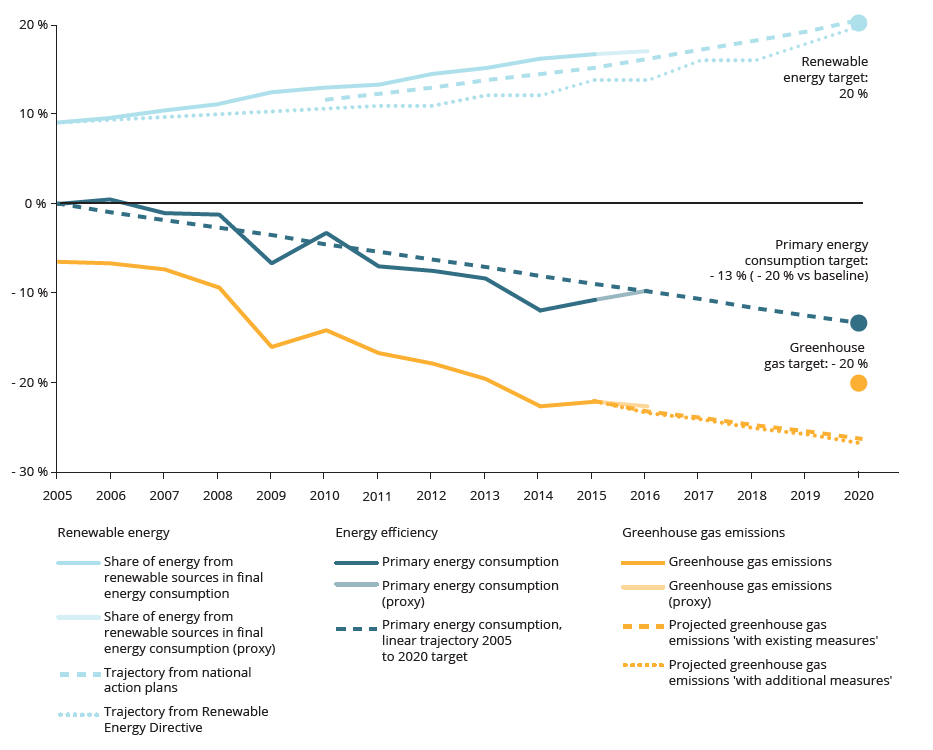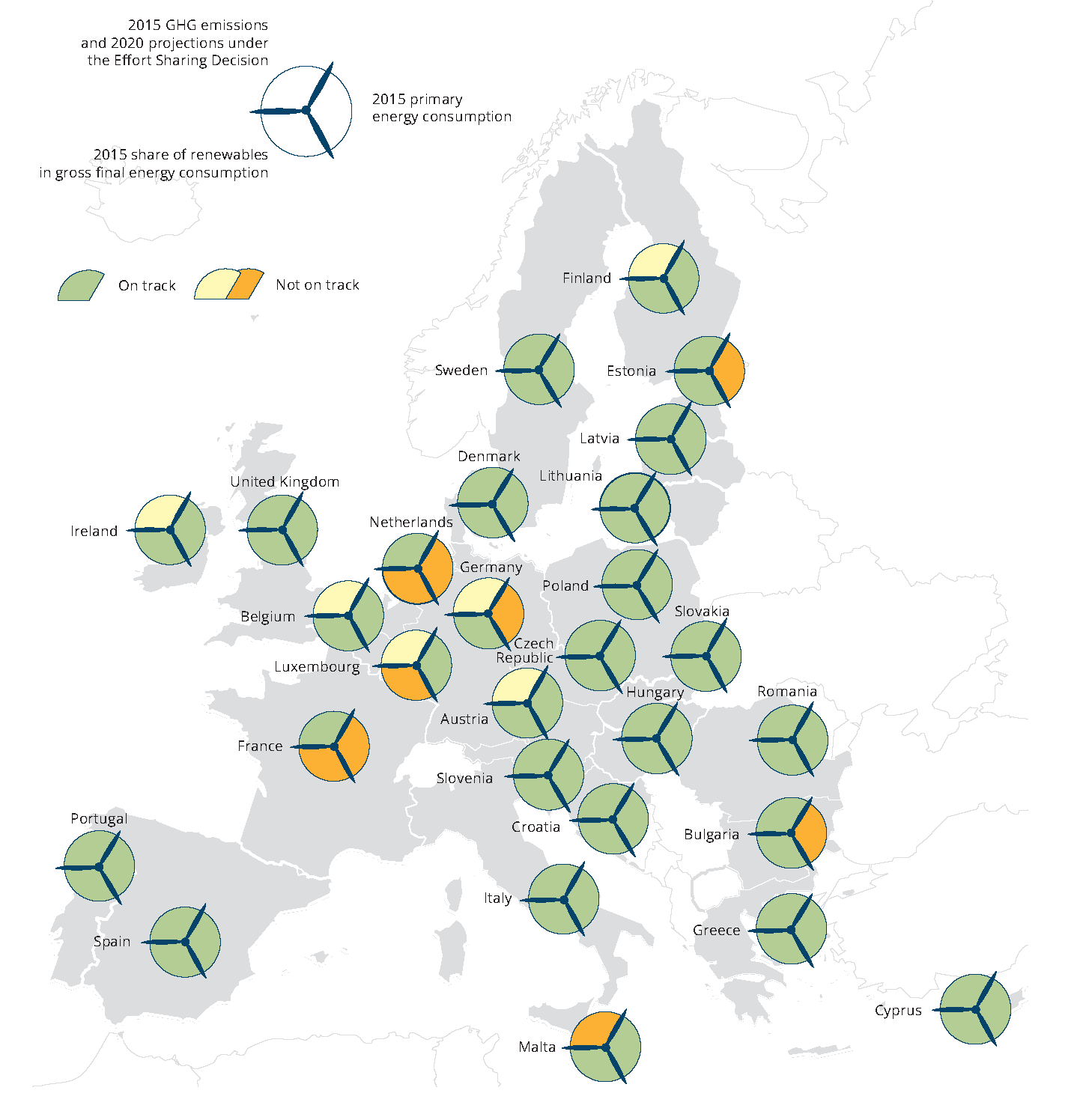The 2017 edition of the European Environment Agency (EEA) Trends and projections in Europe report confirms that the European Union (EU) is well on track to meet its climate and energy targets for 2020. Official data for 2015 show that greenhouse gas (GHG) emissions have already decreased beyond the 20 % reduction target and energy use from renewable sources is steadily growing and getting closer to the 20 % target. Energy consumption levels, while currently considered to be on track to meet the EU energy efficiency target, have increased slightly meaning greater efforts are needed to reach this target (see Figure ES.1). Policies are playing an important role in driving the overall EU trends observed since 2005, in particular through a sustained increase in renewable energy use.
According to preliminary estimates for 2016, greenhouse gas emissions show only a modest decrease compared with 2015, when GHG emissions increased for the first time since 2010. The reduction in 2016 took place despite an increase in transport emissions. Primary energy consumption increased in 2016, for the second consecutive year. This increase follows a large drop in consumption in 2014, due to an exceptionally warm winter that resulted in a particularly low energy demand for heating.
Insufficient progress has been achieved so far towards the 10 % target for renewables set for the transport sector for 2020.

Explore
Notes: For renewable energy, the figure represents the trend in the share of energy from renewable sources in gross final energy consumption since 2005. The 2020 renewable energy target corresponds to a share of 20 %.
The 2020 target for energy efficiency was defined as a 20 % saving in energy consumption compared to the 2007 Energy Baseline scenario of the European Commission. This is equivalent to a 13 % reduction of primary energy consumption (or an 8 % reduction in final energy consumption) from 2005 levels. The figure represents the relative change in primary energy consumption since 2005.
The 2020 target for greenhouse gas emissions corresponds to a 20 % reduction from 1990 levels. The trends and projections represented in the figure correspond to relative changes in emissions compared with 1990 levels. The projections are presented in the 'with existing measures' (WEM) scenario, which reflects existing and currently adopted policies and measures.
Source: EC, 2013; EEA, 2011, 2017a, 2017b, 2017c, and 2017d; EU, 2009 and 2012; European Council, 2007; Eurostat, 2016a, 2016b and 2016c.
The report uses official data for 2015 to look at the progress of Member States towards their individual objectives for 2020 (see Figure ES.2). Here progress is mixed: while the EU is on track, the situation differs between Member States.
- 21 Member States are on track to meet their 2020 GHG targets under the Effort Sharing Decision, which cover national emissions from sectors outside the EU Emissions Trading System (ETS). All except Austria, Belgium, Finland, Germany, Ireland, Luxembourg and Malta project that their GHG emissions will be kept or reduced below their national targets in 2020, with the current set of policies and measures in place. Malta did not reach its 2015 ESD target.
- 25 Member States are on track to reach their 2020 renewable energy targets. All except France, Luxembourg and the Netherlands used more renewable energy than the minimum level indicated in the Renewable Energy Directive for 2015-2016.
- 23 Member States (all except Bulgaria, Estonia, France, Germany and the Netherlands) are on track to meet their 2020 energy efficiency targets on the basis of their consumption of primary energy in 2015. However, the overall ambition level of Member States is still insufficient: the sum of the 28 national targets for 2020 primary energy consumption does not match the reduction target determined at the EU level.
A total of 17 Member States are on track to deliver on their national targets in all three areas. This is an improvement on 2014, when the figure was 16. However, preliminary data indicate an overall deterioration of the situation in 2016 compared with 2015, in particular when it comes to progress towards national energy efficiency targets.

Note: The colours indicate whether countries are considered on track or not towards their 2020 climate and energy targets.
For greenhouse gases, orange means that 2015 emissions covered by the Effort Sharing Decision (ESD) were above the 2015 national ESD target. Yellow means that projected ESD emissions in the 'with existing measures' scenario for 2020 are above the 2020 national ESD target.
For renewable energy, orange means that the 2015 share of energy from renewable sources (RES) in gross final energy consumption was below the indicative level from the Renewable Energy Directive.
For energy efficiency, orange means that the 2015 consumption in primary energy was above a linear indicative trajectory between the 2005 level and the 2020 national target.
Further methodological details on how progress is measured are provided in Annexes 1, 2 and 3.
Source: National information reported by Member States to the EEA, the European Commission and Eurostat. See Chapters 3, 5 and 7 for further details, as well as Annexes 1, 2 and 3 for information on data and methodology.
EU progress towards 2030 climate and energy targets
Although the EU remains on track to achieve its 2020 targets, current efforts need to be stepped up to achieve more ambitious longer term objectives.
For example, while projections show further decreases in EU GHG emissions beyond 2020, Member States project that the pace of these reductions will slow down. The reductions currently planned fall short of the 40 % reduction target for 2030.
Good progress towards the energy efficiency targets took place between 2005 and 2014, but the pace has slowed in recent years, increasing the uncertainty around the EU meeting its 2020 energy efficiency objectives and, even more so, the target for 2030. Meeting the 2030 target for energy efficiency in the EU will require Member States to strengthen their efforts to keep energy consumption in check, particularly if current economic growth continues, and be steadfast in implementing relevant policies and measures in an adequate and timely manner.
Maintaining the current pace of renewable energy deployment across Europe would enable the EU to achieve the target of at least 27 % of final consumption of energy from renewable sources by 2030. However, this may not happen without additional efforts to overcome a number of difficulties:
- past regulatory changes have affected investors' confidence;
- the dated structure of current energy markets inhibits a more flexible operation of the system and prevents consumers and other players from participating actively in the market;
- barriers for cross-border electricity trade still exist;
- the grid and its interconnections need to be expanded.
To address these issues and achieve the EU's 2030 climate and energy targets, as well as its international commitment under the Paris Agreement, policy proposals from the Commission are currently under discussion between Member States and at the European Parliament. These proposals include a revision of the EU ETS, a proposed Effort Sharing Regulation setting binding national emission limits on sectors outside the ETS, the integration of land use and forestry in the policy framework, the recast of the Renewable Energy and the Energy Efficiency Directives, and a proposal for governance of the Energy Union.
Where voluntary national efforts will replace the binding national targets for renewables post-2020, the new governance system will aim to ensure that national policies and measures adequately support the transition to a low-carbon, competitive EU economy and safeguard the achievement of the EU-level targets in 2030.
Outlook for greenhouse gas trends in 2050
The 2017 analysis of progress towards long-term decarbonisation targets in the EU has not changed since the 2016 assessment: although the EU and its Member States are making good progress towards their short-term goals on climate and energy, they will have to intensify their efforts considerably to meet longer-term energy and decarbonisation objectives for 2050. The pace of GHG emission reductions after 2020 should actually increase in order to achieve targets, rather than slow down as is currently projected by Member States. Assuming the necessary emission cuts required to achieve the 2030 target actually take place, an even deeper reduction would still need to be achieved after 2030. This reduction will have to be two to three times greater than the decrease from current levels necessary to meet the 2030 target, which is itself greater than that achieved since 1990. In short, ambition levels need to be significantly stepped up.
Achieving the EU's long-term decarbonisation objective can take place only in the context of a major transformation of the EU's socio-technical systems such as the energy, food and mobility systems. As the effects of policies and measures often take time to materialise, action aimed at achieving the long-term targets cannot be delayed. Member States should take into consideration the long-term mitigation potential of their existing and planned measures. Few European countries have translated their national climate and energy objectives into corresponding investment needs and plans. Countries should identify and make available clear information on investment needs and priorities in order to strengthen investor confidence, increase investment attractiveness and provide certainty in terms of the direction and nature of forthcoming investable projects.
Sources: EEA, 2017a, 2017b, 2017c, 2017d
About this report
The 2017 edition of the annual European Environment Agency (EEA) report, Trends and projections in Europe, provides an updated assessment of the progress of the European Union (EU) and European countries towards their climate mitigation and energy targets. The report is based mainly on national data on greenhouse gas (GHG) emissions, renewable energy and energy consumption for 2015, preliminary ('approximated' or 'proxy') data for 2016 and projections reported by Member States concerning expected trends in GHG emissions until 2035.
EEA reports
This report is part of an annual series of EEA reports on climate change and energy. In particular, this report is linked to EEA report No 18/2017, 'Trends and projections in the EU ETS in 2017', EEA report 'Approximated EU GHG inventory: Proxy GHG emission estimates for 2016', and EEA report 'Analysis of key trends and drivers in greenhouse gas emissions in the EU between 1990 and 2015'. All EEA reports are available at: eea.europa.eu.
About the EEA
The EEA is an agency of the EU. It aims to support sustainable development and to help achieve significant and measurable improvement in Europe's environment by providing timely, targeted, relevant and reliable information to policymaking agents and the public. It is supported in its work by the European environment information and observation network (Eionet), a network of 39 European countries.
Authors
This report was prepared by the EEA and its European Topic Centre on Air Pollution and Climate Change Mitigation (ETC/ACM). The ETC/ACM is a consortium of European institutes that assist the EEA in its support to EU policy in the field of air pollution and climate change mitigation.
The overall coordination of the report was carried out by Melanie Sporer (EEA) and the ETC/ACM task manager, Sabine Gores (Öko-Institut, Germany).
The authors were, in alphabetical order, Anca-Diana Barbu, François Dejean, Melanie Sporer and Mihai Tomescu (EEA); Hannes Böttcher, Hannah Förster, Sabine Gores, Anne Siemons (Öko-Institut, Germany); and Larissa Pupo Nogueira de Oliveira (Vito, Belgium).
Document Actions
Share with others